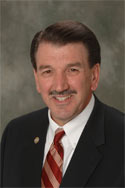According to the higher education leaders, many elected officials, faculty, students, staff and the general public, higher education budget cuts will send universities, and therefore their states, into decline. Wisconsin’s Governor Scott Walker’s budget proposal last week included a decrease of $300 million in state support for higher education. It amounts to 13% according to the New York Times. Rebecca M Blank, leader of UW Madison, the flagship campus, said if she eliminated the Schools of Nursing, Law, Business, Pharmacy and Veterinary Medicine she’d still have to find other places to save money.
Things aren’t much better on the East Coast. Connecticut Governor Dannel P. Malloy has proposed a budget that stipulates a $40 million hole in the University of Connecticut, the diamond in the necklace of higher education in the Constitution State. UCONN President Susan Herbst said that “managing a reduction of that size will necessitate deep and significant cuts throughout the University.” Malloy left public education alone but did propose additional resources for special charter and magnet schools. Presumably these institutions are producing good results, but the jury is out.
In the desert Southwest, Arizona Governor Doug Ducey also brought out the hatchet, hacking $75 million, or 10% of state support to public higher education. Some say Ducey didn’t go far enough. Interestingly, Eileen Klein, President of the Arizona Board of Regents, is not sure about the cuts and their impact but does like the liberating potential of a stronger “public – private” approach to higher education. Michael Crow, at Arizona State University made international news with an inventive initiative to provide educational opportunity to Starbucks employees. The partnership offers reduced cost study through ASU to all Starbucks employees. Like it or not, it’s innovative and forward-looking.
Stringent financial times are driving many institutions into the ground. However, those same conditions prod other institutions to reflect diligently on what they do for whom, why, when, and how they do it, and to what effect. Leadership must ask legitimate questions of faculty and administrators in a shared governance, shared responsibility environment. It will advance a form of unparalleled academic freedom and ideation.
Governor Bobby Jindal’s seemingly merciless reductions in funding higher education are attributed to a potential presidential bid in 2016. This year, he’s trying to plug a $400 million shortfall. Both he and Governor Walker are being chided for appealing to the hardest right-leaning base of the Republican Party. Maybe, maybe not. The pension systems, ancillary costs, luxurious un-necessaries, and a multitude of other forces are driving the cost of education up while state revenues are disappearing in too many states in the nation.
And finally, Illinois freshman Governor Bruce Rauner proposed a budget with $6 billion in cuts to universities and other state enterprises. Rauner says this budget is “honest with the people of Illinois.” If that were the case it would be a refreshing change considering how many former state leaders served time, or are currently in state pens, for abject dishonesty. For Illinois universities a reduction of over 30% in state support is called for. Not to trivialize the amount, but for some institutions in and out of Illinois, state support is less than15% of the total budget. Nonetheless a 30% drop in state funding requires that university leadership bring out the ax and chop off “business as usual” at the root. “Oh, I believe in yesterday” won’t work, no matter who’s running for what or which political party they represent.
If only one state were involved, these kinds of cuts could be blamed on a misguided state leader. But it’s not just one state. In fracking insulated North Dakota universities must change because mission is changing, even though the Peace Garden State has more resources than ever. Governor Jindal was a university president. Did he forget that? Many in Wisconsin claim that Scott Walker has disdain for higher education. “He never even graduated from Marquette,” they say. And it’s true. However, holding a degree from a university proves no love, appreciation, understanding, or concern for higher education. University presidents have pilfered for personal profit at universities from which they have been given PhD’s while the institutional trajectory spiraled downward.
It is illuminating that reporting on higher education budget reductions occur in the “politics” sections of newspapers. In the “higher education” sections imagine headlines like these:
“New Tax Breaks Promote Record Private Giving To Higher Ed”
“Groundbreaking Liberal Arts Program Stipulates 50% of Degree Requirements Acquired off-shore”
“Coalition of University Presidents Proposes 401K Style Pensions for All Campus Employees”
“State Flagship Outsources Everything but Teaching and Research: Returns to Basics”
“Intercollegiate Athletics Programs Sold to Spectrum Sports Management, Inc.”
“New Pricing Structure Calibrates Costs to Combination of Student Ability to Pay and to Learn”
“Scholarships to Community College Graduates Equal Those for New Freshmen”
“Reduced State Oversight: Faculty Say Academic Freedom Up while Student Cost is Down”
“University Degree Provides New Opportunity for 338,875 Toyota Employees Worldwide”
“Tuition and Fees Set At 237 Different Levels Depending on Student and Academic Program”
Just a few thoughts and I know: I am dreaming.




 with one ticket for himself and one ticket for Murphy, Sianis and his pet watched the game until late in the game when they were asked to leave. Orders came directly from Cubs owner, P.K. Wrigley, asking that both Sianis and his pet goat be ushered out of the park. The reason given was “because the goat stinks”. As a disgusted Sianis left, he was heard saying “The Cubs ain’t gonna win no more. The Cubs will never win a World Series so long as the goat is not allowed in Wrigley Field.”
with one ticket for himself and one ticket for Murphy, Sianis and his pet watched the game until late in the game when they were asked to leave. Orders came directly from Cubs owner, P.K. Wrigley, asking that both Sianis and his pet goat be ushered out of the park. The reason given was “because the goat stinks”. As a disgusted Sianis left, he was heard saying “The Cubs ain’t gonna win no more. The Cubs will never win a World Series so long as the goat is not allowed in Wrigley Field.” Jenkins, and Billy Williams. It was considered to be the greatest Cubs team ever assembled.
Jenkins, and Billy Williams. It was considered to be the greatest Cubs team ever assembled.

